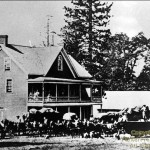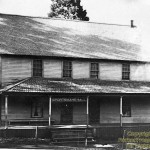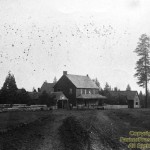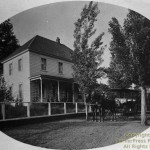When the word “GOLD” resounded around the world, it started first a trickle, then a steady stream, then a rushing torrent of eager adventurers into El Dorado County, mostly over Carson Pass or Johnson’s Summit. To provide for the needs of these anxious and weary travelers, road houses, inns, waystations, and toll houses sprang into being almost overnight. During the peak of the prospecting and mining period, there was a stopping place about every mile along every road from Carson Valley to Sacramento.
Many of these places were preempted. In 1841, Congress passed a preemption law that allowed all squatters who settled on surveyed government land and made improvements on it, the right to buy that land before anyone else could do so. When the land he occupied came up for sale, a man could buy up to 160 acres for $1.25 an acre. This system was abolished in 1891 due to acquisition of large tracts of land by some individuals, through misuse of the law.
Some of the more important stations from the present Cedar Grove area to Riverton along the old Placerville-Carson Valley road were as follows:
10 mile house
The place 10 miles east of Placerville, was known as Mountain Cottage, and was located on the south side of the road, (now called Pony Express Trail). It was preempted in 1853 by Brigett Barney. A 5 inch thick plank road ran past this area all the way to the 14 mile house.
11 mile house
This was at times called the 12 mile house. It was and is Sportsman’s Hall. Sportsman’s Hall, Fyffe post office, was probably the most important stage stop east of Placerville throughout the years. It is one of the few establishments to almost continuously, except for periods of rebuilding, serve the public’s needs for refreshments from the gold rush era to the present time.
In 1853 D. C. Deady discovered and claimed one hundred sixty acres of ridge top land about 12 miles east of Placerville on the Placerville-Carson Valley Road and there established a ranch. The ranch encompassed a building on the road frontage that became known as Sportsman’s Hall.
John Blair preempted 160 acres adjacent to Deady’s land in 1853, just 3 days after Deady. In early January of the following year, for $760, Deady sold all of the land, ranch, livestock and buildings, including Sportsman’s Hall to John Blair who was one of four brothers from Scotland. The other brothers were still in the east. John Blair and a partner Gould leased part of the land east of the “Hall” to Mr. de Arroyave, a sawmill operator. El Dorado Mill was established here. Mr. de Arroyave was, by contract, not to build any hostelry that would compete with Sportsman’s Hall.
Due to the gold mines of the Mother Lode and the Comstock Lode of Carson Valley, Sportsman’s Hall flourished. Every man, wagon, and stage going either way that did not divert through Pleasant Valley, passed directly in front of Sportsman’s Hall. James Blair came west and became a partner with his brother John. Together they enlarged the hotel and stables and soon the Hall became noted for its superior quarters for teams and teamsters. Seven daily stages stopped at the “Hall” to change horses. As many as 500 horses could be stabled there with more in the corrals. The dining room could accommodate as many as 150 people. Hundreds of freight schooners often camped along the road, lining it from the Hall to the bend west of the Hall. A horse had to work night and day to draw enough water from the well to provide for all the stock and needs of the travelers. Sportsman’s Hall was a home station of the much romanticized Pony Express.
Sportsman’s Hall was an impressive, large, 2 and 1/2 story building with a porch across the full width of the first floor and a veranda running the full width of the second floor. The barns and stables were to the west. At times when freight was delayed due to storms, as much as two tons of bullion might be stacked in sacks in the hotel.
The Hall burned in April of 1868. An article in the Mountain Democrat published in Placerville on April 25th stated, “This valuable Hotel 12 miles east of this city on the Nevada road, was burned down Sunday between the hours of 1 and 2 p. m.” Smoke was detected coming from the ceiling of the kitchen, but there was only enough time to save a little of the furniture. The hotel was insured for $3000, only about one fourth of its cost. It was immediately rebuilt.
With the completion of the railroad in 1869, traffic on the road began to diminish. The interests of John and James Blair were turning to lumbering and they leased out the hall.
In 1886 Charles and Clara Hogan of the Ringold area were operating Sportsman’s Hall as a resort hotel. Their daughter Cora was married at the Hall by Reverend Caleb Charles Peirce to Nelson C. Butler. Nelson’s father had homesteaded the Butler Ranch on the west side of Randolf Canyon, just east of the present Forebay Lake.
The Hall again burned and was rebuilt. This time the building was a somewhat less imposing structure. It was two stories with a porch across the entire main floor, but had no second story veranda.
In the early 1900’s Alexander and Julia Baumhoff purchased Sportsman’s Hall from J. and J. Blair Logging and Lumber Company. The Baumhoffs and their four children, Mertie, Emma, Fred, and Bill, worked hard to keep the place in good repair and service as both a resort hotel with barns and stables, and as an eating establishment. Emma’s job as a 6 year old was to keep the chimneys on the lanterns clean. Alex Baumhoff planted pear and apple orchards to the south. He also had extensive land and timber holdings throughout the area.
The two older Baumhoff children attended school in Placerville, while the two younger children attended the one-room Cedar Grove School up the road to the east. The road was closed east of Sportsman’s Hall in the winter so the younger children only went to school in the summer.
The Baumhoffs retired from the hotel business in the early 1920’s, and the Hall was rented to Judge Dutch Holland, who moved into a small house to the west. Alex moved to Placerville.
In 1935 Bill Baumhoff and his wife, Ruth, returned to Sportsman’s Hall. Ruth began teaching in the now two-room Cedar Grove School. The logging industry in the area was growing, but the demand for a hotel in the area was decreasing. So Bill decided to tear down the Hall and use some of the lumber to build a small house to the east. Some of the lumber was used to remodel the old barn into a small donut shop. This barn is the main room of the present restaurant. The kitchen and storage areas were added. The hand hewn beams of the old barn can still be seen.
Bob and Phyllis Balmain bought Sportsman’s Hall in 1949 and were joined a short time later by Phyllis’ parents, Carroll and Louise Laniger. The dining room was added about 1960. The two large trees west of Sportsman’s Hall had to be cut down, but the stumps remain as a reminder of the rich heritage of the place.
The fare, ease of preparation, and storage of food has changed a great deal since the time of the Blair brothers, but the fame of Sportsman’s Hall lives on. Travelers in this area still come to dine at Sportsman’s Hall, some expressly for this purpose.
12 mile house
Ezekiel Spicer bought the Illinois House at a Sheriff’s tax sale in 1855. He then leased the tavern, inn and ranch to H. Brighton in 1862, and sold it to him 2 years later for $2000. According to Sioli’s book, the Illinois House had groceries and meals at all hours.
13 mile house
Duncan McLean was proprietor of the Thirteen Mile House and its accompanying 160 acres. This was not at the location of the present 13 mile stone, but at the site of the present Pollock Pines School. McLean sold it to James McKinley in 1861. It was a popular stopping place until it burned in 1867.
14 mile house
Possibly called Mountain Ranch, the 14 mile house was located on the western terminus of the Ogilby Road (the northwest corner of the Safeway parking lot). It was convenient to the traffic going over Johnson’s Cut Off or Ogilby Road. It was the George Holcomb House in the early twentieth century. The stage made a mail stop there by the grand old cedar tree. It also made a stop in front of the old school house where the mail hung on a large hook. Mr. Rupley, the stage driver, could reach out and grab the mail as he drove by. The “stage” in later years was a large touring sedan.
Bob Blair’s Station
Bob Blair’s Station had 60 rooms and was located where the PG&E camp is now, just west of Fresh Pond. It is said that the Bullion Bend stage robbers stayed there before the robbery.
Fresh Pond
Fresh Pond House was owned by Peter Watt. It could accommodate traffic from either direction. Travelers could come up from Pleasant Valley through Sly Park, turn northeast and come in on the south side of Fresh Pond or could come up the ridgetop past Sportsman’s Hall, past Bullion Bend, and then come in north of Fresh Pond. In later years there was a succession of saw mills, mill houses, a rooming house, a restaurant, and a school, as well as an ice skating rink, a toboggan run and an Olympic try-out ski jump located in the immediate vicinity.
Pacific House
Pacific was an original toll house and stage stop built by Wheeler Bartram in the early years of the gold rush. It was called Pacific House Ranch after Bartram’s Pacific Sawmill. Bartram had extensive lumbering interests over much of the county. He also built a toll road through the area. Brockliss Bridge crossed the river just east and down the hill from Pacific. Bartram sold the hotel in 1865, possibly to Mason and Killough, who were partners in mining near Silver Creek below Ice House. It is said they took $80,000 from the old gravel channel in one clean-up. The inn served 200 people a day. Mrs. Killough, as a safety precaution, tied her little daughter in a rocking chair while she cleaned the rooms. Bud Cook, a descendent, still has the chair and a gold nugget found while digging the ditch.
James Zimmerman bought the property in 1885 and continued to operate the hotel. Rufus and Estella Poole bought Pacific House Hotel in 1909 and operated the business until 1946. Their son, Floyd, had been born in Placerville in 1903. The family then moved up to the ditch tender’s house. His father was a ditch tender before they bought Pacific House. Floyd was an avid historian regarding the early roads and inns. He was a fountain of information and related many interesting stories. He said, “the ‘House’ was added to Pacific when the town of Pacifica came into being to save postal confusion”.
Pacific House was a later day stopping place with rooms and meals for the drovers, and barns and corrals for the cattle being driven up the hill for the summer and fall. There was also a ski jump there, on the north facing slope south of the hotel. The Blairs had a mill across the river canyon from 1928 until 1958 and built a bridge over the river near the old Brockliss Bridge crossing.
Moore’s Station
Moore’s Station (Riverton) was originally located up on the Johnson’s Road. When the Brockliss Bridge burned, the station was moved down to the river as the upper road traffic abruptly stopped. According to the author of The Saga of Lake Tahoe, “Moore’s was the first station east of Sportsman’s Hall to service the Central Overland Express.”
Mrs. Ellen Brockliss took over the station in 1860 and renamed it Fountain House. A poster advertising the new station at this location was brought to the Record Courier newspaper office in Gardnerville, Nevada in 1928 by a Brockliss descendant.
BROCKLISS
NEW STATION
1 1/2 miles beyond Petes Ranch
FOUNTAIN HOUSE
I would inform the public that my house on the Placerville and Carson Valley Road, is twenty three miles from Placerville, eleven miles from Sportsman’s Hall, three miles from Brockliss bridge, and a mile and one half beyond Pete’s Ranch. I have hay, barley, a good stable, and stock corrals: plenty to eat and drink, good beds, also, good rooms for families.Mrs. E Brockliss, Proprietress.
April 10, 1860 – Mountain Democrat print
The hotel was located on the west bank of the river and was built out over the river. It was a three story building that could house up to 75 guests. The barn and corral were on the east bank of the river. Her husband, Anthony Richard Brockliss, built Brockliss Bridge and Brockliss Road in 1857. While his wife managed the hotel, he cut and hauled lumber and ice to sell in Placerville. He also panned for gold. Richard had come to America in 1844 and established himself in Iowa in the tailoring trade. When gold was discovered, he decided to come to California and try his hand. He panned for gold along the American River for a year or so. In 1851 he traveled to Salt Lake City and married Miss Ellen Turner. He returned to Placerville with his bride and soon they settled in the area about 20 miles east of Placerville, where he built his bridge and road. Four children were born to Ellen and Anthony while they were in the area: Anthony Richard Nevada (Tony) born in 1852, John Fredrick born in 1855, Sarah Ellen born in 1857 (she did not live more than a month), and William Albert born in 1860. Tony told his grandson how he treasured the small black kitten brought to him at the Fountain House by Hank Monk, the famous Butterfield Stage driver. The Brocklisses moved to Carson Valley to raise their family shortly after establishing this station. There were nine more children born to Ellen and Richard Brockliss in Nevada, then the Utah Territory. There is a creek with the Brockliss name south of Genoa, Nevada.
In 1925 the highway realignment map shows the hotel, a dance hall, a store, several summer cottages, a house, a garage, and a service station across the road in front of an orchard. The corrals were still located on the other side of the river across an old stone arch bridge. The hotel burned in 1928 and further straightening and widening of the highway removed all traces of the buildings.
Following are a few of the stations along the Ogilby Road:
15 mile house
It was preempted by Louis Lepettit in 1860. It consisted of 360 acres, a house and Union House Hotel and was located where Sly Park Road joined Ogilby Road. It may have later been called Junction House.
Pennsylvania House
It was on Ogilby Road south of Pacific on the hill. It was not a large place.
Esmeralda House
It was also a Lepettit enterprise. It was a large place one mile up the canyon from Esmeralda Falls (now known as Bridal Veil Falls). There was some mining activity below the House on Plum Creek.
An interesting story is told about the early miners. They would sometimes hide their gold before entering a road house, but after a night of drinking, by morning would often forget where they had hid the gold. There has been much speculation as to where that gold may now be.
From the late 1800’s until 1910 or so, the only buildings of any kind in the area, other than Fresh Pond, Pacific House, and Riverton, were: Sportsman’s Hall, surrounded by hay fields; a water tank to water the unpaved roads; the old one-room board school on the present Pollock Pines School site; 14 mile house; and scattered ranches of the Shermans, Butlers, Crockers, Starks, Robinsons and Tofflemeyers. The end of an era had indeed come.
All images for this chapter, and additional photos not in the original book are shown below.
Photo Gallery for Inns and Waystations
- The first Sportsmans Hall
- Pacific House about 1910
- The second Sportsmans Hall
- A distant view of the second Sportsmans Hall








